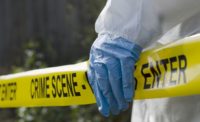Crime Scene Restoration: Responding when Chaos Ensues
Cleaning up after the Ferguson Riots






On Aug. 9, 2014, Ferguson, Missouri found its place on the map – not by choice. Many of you will remember that’s the day Michael Brown was shot and killed by former police officer Darren Wilson. The shooting stirred strong emotions amongst some in Ferguson, and violent riots and chaos ensued. Alongside peaceful protests, some people chose to resort to looting and all-out destruction. The U.S. military was quickly called in for backup, curfews instated, and riot squads sent onto the streets to try to maintain order.
The first wave of violence lasted two weeks; then some peace was restored. However, second and third waves ignited when Darren Wilson was not indicted for the deadly shooting, and this year on the anniversary of Brown’s death.
|
“We were working about 12 to 14 hours a day. Three of my people had body armor on who stood up front, and then my crew worked inside. I had guards who were there and on call and watching everything that was going on. I was concerned about the safety of my crews.” — Mike Sellenshuetter, Owner, CSM Restoration |
Throughout it all, more than 200 people were arrested and 16 people hurt, including six police officers.
In the center of all the chaos, CSM Restoration in St. Charles, Missouri, got a call from Walgreens. In the restoration business since the 1980’s, owner Mike Sellenschuetter had experience responding to unique situations. He and part of his team spent 15 months helping with restoration efforts after Hurricane Katrina. When the Ferguson riots started, his 1-800-BOARD-UP franchise was called in to close up and assess some damaged Walgreens locations.
“I think we handled all of the Walgreens damaged in the Ferguson issue,” Sellenschuetter said. “We would go in and basically, if there was damage, [Walgreens corporate] would ask us to show up and assess the damage, take some photos, and send that to them. They would then review the documents and give us a work order saying do the board up, inspect the inside, and let us know if there is smoke or looting that’s been done.”
Sellenschuetter said while some of the stores just had very minor damage, others suffered much worse.
Working with Walgreens corporate proved to be pretty fluid. Throughout the day, every day, Sellenschuetter and his team were on conference calls with Walgreens, working through the issues like product and structural damage, pharmacy issues, etc. That helped them quickly figure out the next step in remediation and restoration for each store.
“A couple had fires and such. One was a complete gut all the way down to the studs,” he reminisced. “[Rioters] basically broke the glass out of the doors, went in and started a fire up front in the store. We’re not even sure how long it burned, but the smoke residue was intense and everywhere – including in the pharmacy.”
Due to the heavy smoke damage and residue, Walgreens decided everything in the store had to be thrown out, including all the drugs in the pharmacy. Taking care to act wisely, the CSM Restoration crew did not access the pharmacy until Walgreens pharmacists and staff were on site.
“They did all the handling of the meds, and we came in and removed all the shelving and items not pertaining to the meds,” Sellenschuetter said. Hazmat crews also handled any chemicals on site.
At every location, there was a time crunch and the stores wanting to reopen as soon as possible. During the total gut, CSM Restoration had multiple dumpsters brought to the site and crews worked the longest hours they could, keeping safety in mind. As soon as one dumpster was full, it was carted away and another put in its place. Still, getting items to the dumpster in the first place was a bit of a process. About a dozen people worked inside dumping items into trash carts. Those were wheeled to the front of the store, then dumped into a big container on the front of a Bobcat, then that was driven to a dumpster outside.
“We were working about 12 to 14 hours a day. Three of my people had body armor on who stood up front, and then my crew worked inside,” Sellenschuetter explained. “I had guards who were there and on call and watching everything that was going on. I was concerned about the safety of my crews.”
While crews worked on the gutting, people on the streets would walk up and try to get into the store. Sellenschuetter said he didn’t force any of his employees to work on these projects – he gave them a choice, but said quite a few felt comfortable doing the work and nerves calmed pretty quickly after a couple hours on site.
“You don’t know what to expect. You don’t know who’s going to come into the store, who’s going to be armed or not, try to cause more damage,” he said. “I was on site through the whole process. I wouldn’t expect my employees to go down there and me not go. There was a heavy police concentration around on the streets, there was the National Guard. We felt pretty safe.”
Despite tensions on the streets, Sellenschuetter is pleased to say he and his crews had no major issues at any of the stores.
Prepared for CAT Losses
Sellenshuetter says being a contractor for DKI helped get CSM’s CAT Response Unit on the map years before the Ferguson Riots – from situations like Hurricanes Katrina and Irene, and Superstorm Sandy.
“We aren’t chasers. We don’t go out and chase storms, generally we get invited by insurance companies,” he said. “They want teams on the ground who they know will respond, do a good job, do a quality job, and be fair to their clients.”
While not necessary in Ferguson because it was near home base and not a widespread loss situation, Sellenschuetter says he’s carefully evolved his CAT Response Unit since Katrina.
“Through Katrina, we learned to set ourselves up differently. Now, if something happens, we’ve got equipment to keep people on site. We’ve got a travel trailer that can sleep 12 people, I can carry with me up to 12 hundred gallons of fuel, I’ve got a kitchen so I can cook for my people, “ he explained. “We can go into an area and be self-contained for four to six weeks.”
Meanwhile, the rebuilding and healing process continues in Ferguson, Missouri. According to a local TV station, companies throughout the St. Louis area contributed $1.2 million dollars to turn a convenience store looted and burned in the riots into a job training center. However, for some, recovery has been slow. According to an August article in NPR, some areas previously vibrant and flourishing are not dotted by empty lots and places where burned buildings have been demolished ahead of reconstruction.
As for Sellenschuetter, his crews have moved on – but will likely never forget the tensions they felt in Ferguson.
Looking for a reprint of this article?
From high-res PDFs to custom plaques, order your copy today!












